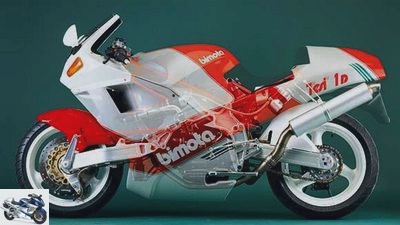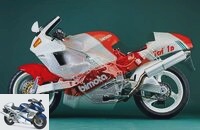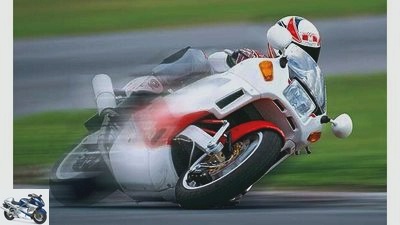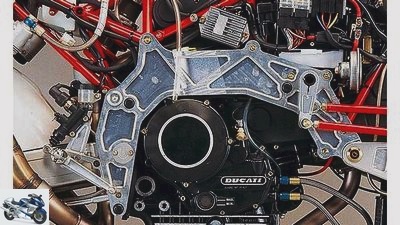Table of contents
- Bimota Tesi 1D 906 with wheel hub steering Ecstatic technology freaks all over the world
- Technical specifications

duke
counselor
technology & future
Bimota Tesi 1D 906 with wheel hub steering
Bimota Tesi 1D 906 with wheel hub steering
Ecstatic technology freaks all over the world
Why easy if complicated is another option? In the early 1990s, the small company Bimota proved that there are alternatives to the telescopic fork. The Tesi 1D 906 with wheel hub steering delighted technology freaks all over the world. Also editor-in-chief Michael Pfeiffer.
Michael Pfeiffer
01/21/2010
Yes, I admit I was one of them too. Like so many, I no longer believed in the telescopic fork in the early 1990s. It was just too limp in front for me with its two standpipes. How was such a windy construction supposed to curb the impetuous forward thrust of the athletes elite at the time? Absorbing braking forces, springs, transferring steering forces, damping? It would be much better to assign these tasks to appropriate specialists. How to separate wheel guidance and steering in a car. I euphorically tested everything that was knuckle-jointed in any way. Mostly do-it-yourself solutions, which usually showed pretty terrible driving behavior. How happy I was when I found out that the small Italian manufacturer Bimota would bring a series machine with a new type of front suspension. And how keen I was to drive this very machine. It had to be sensational: the Bimota Tesi 1D 906 was the bike of my dreams, and in my quiet room I imagined how this front wheel system would work. In the wheel hub there is a tubular steel cross, the vertical part of which forms the steering head, while the horizontal part is held by the two clamping fists of the front swing arm. The steering knuckle engages the wheel hub body, the two brake calipers are attached and the huge wheel bearings run on it. How is it steered? Two meters of pipe and a lot of levers and joints transfer the steering forces to the wheel hub. What a hassle! It just had to be better than a fork.
I got a foretaste of future tests on a beautiful summer day in Misano. Bimota test driver Gianluca Galasso moves out for a few quick laps on the Grand Prix track and chases the Tesi around corners like a madman. It’s unbelievable how weird the man drives, how late he can brake. That was the confirmation of the superiority of the new suspension technology, I was quite sure of that. Suddenly: violent scratching, two or three dull impacts – silence. The unlucky pilot stomps back to the pits. I can not believe it. “What happened?” Galasso grins: “Ingegnere Marconi wanted to know whether the front swing arm touched down when cornering, and I tried it. She doesn’t sit up. The wheels slip away beforehand. “Oh, yes. Pierluigi Marconi is Bimota’s chief engineer and he is in charge. He can be tested hard and also has the necessary hard tester.
Buy complete article

final
Bimota Tesi 1D 906
6 pages) as PDF
€ 2.00
Buy now

duke
Spectacular technology: the front wheel of the Tesi is also guided by a swing arm. The steering is located in the wheel hub and is guided to the handlebars via an elaborate linkage.
I’m allowed to answer a year later. Bimota importer Reinhold Kraft gives me a piece of high-tech that costs 61,420 marks. I am trembling with excitement. The starter starts the tuned Ducati four-valve Desmo with difficulty. There is a loud rumble from the pots that have barely been steamed. Funny, when you sit on it, you don’t see the Tesi’s strange front suspension at all. Bimota hides almost the entire chassis technology under a rather bulky full casing. But maybe that’s a good thing. Because then you don’t see the disturbing filigree braking torque supports and steering linkages. Just drive and enjoy. The striking handiness, the extreme braking stability, the strong pulling engine. At every stop I get astonished looks. Looks kind of crazy, the swingarm sticking out of the front panel. It is not without pride that I steer back and forth a little while standing. On the highway, and then it happens: The Tesi begins to lurch terribly, with 160 things so strong that the front tire squeaks. Has my last hour struck now? I come to a stop on a large motorway bridge. Everything is fixed in the front, also in the back, what happened? Reinhold Kraft frowns. “Maybe the tapered roller bearings have settled in the hub. We have to check that. ”I was already rid of the Bimota.
A week later, the same thing again. Whatever Reinhold and his workshop gurus have done, it works. I’m going to Hockenheim, I speed up the A3 to Cologne and back, I rub the tires down a lot, the Tesi still wobbles a bit. But that can be tolerated. The much too hard front shock absorber is not. I give the Tesi back with full respect for the constructive performance and the manual skills of the Bimota team. But a new world in terms of chassis did not open up to me. No, unfortunately not.

duke
It’s unbelievable how weird the man could drive.
Yet. The separation of the suspension and steering is now a bestseller. I beg your pardon? Sure, of course! Telelever, BMW R 1200 GS and their relatives. The tubes transmit the steering forces, the swing arm the braking forces, and the shock absorber cushions and dampens. Works great. So I was right after all. At least a bit.
The Bimota Tesi has not been much more than an eye-catcher to this day. It was just too expensive for that. Bimota produced a total of 366 machines with the four-valve Ducati V2. And they probably all ended up in the hands of collectors. Good for those who have one with them.
Technical specifications

duke
Powerful: aluminum plates milled from solid hold the Bimota together and take up the two wings. Arm on: Ducati engine.
Engine:
Two-cylinder four-stroke 90 degree V engine, four valves per combustion chamber, desmodromic control, bore x stroke 94 x 68 millimeters, 904 cm3, 83 kW (113 hp) at 8500 rpm, injection, electric starter, dry clutch, Six-speed gearbox, chain drive.
Landing gear:
Composite chassis made of aluminum carrier plates and steel lattice tube structure, wheel hub steering, aluminum swing arm front and rear, each with spring strut, steel steering linkage, braking torque support, double disc brake in front, disc brake in rear, cast wheels, tires 120/70 ZR 17 and 180/55 ZR 17.
Measurements and weight:
Wheelbase 1410 mm, caster 83 mm, seat height 775 mm, weight with a full tank of 213 kg, tank capacity 16 liters, top speed 235 km / h. Price 61,420 marks (1991)
Related articles
-
Kawasaki adapts Bimota technology: patent for stub axle steering
Kawasaki 6th pictures Kawasaki 1/6 Kawasaki has patented a steering knuckle system. Kawasaki 2/6 The Kawasaki system relies on a single-sided swing arm…
-
Bimota Tesi H2 with stub axle steering and compressor for 64,000 euros
Motorcycle fair in Milan EICMA 2021 Presented by Bimota 27 pictures Bimota 1/27 Bimota also offers the Tesi H2 as a carbon edition. Bimota 2/27 Only ten…
-
Honda patent for steering assistant: steers when the wheel slips
Honda 21 pictures Honda Europe 1/21 The Goldwing Tour with DCT in the noble Candy-Argent-Red. Honda Europe 2/21 The color is only available as a Tour…
-
Laverda Bimota – merger of two motorcycles
Fred Siemer 17th pictures Fred Siemer 1/17 An East Frisian collector appreciates the three-cylinder Laverda just as much as special European chassis….
-
Bimota Tesi 3D: Italians are still using Ducati remnants
Cathcart counselor traffic & business Bimota Tesi 3D: Italians are still using Ducati remnants Bimota Tesi 3D Italians are still using Ducati remnants…
-
Motorcycle production at Bimota
Jahn counselor traffic & business Motorcycle production at Bimota This is how one of the smallest manufacturers in the world produces Motorcycle…
-
Youngtimer check: Bimota YB8 (YB6 1000 to YB11)
fac, Frank Herzog, Ralf Schneider, Achim Hartmann, MOTORRAD-Archiv, Yamaha, Reinhold Kraft 14th pictures fac, Frank Herzog, Ralf Schneider, Achim…
-
www.bilski-fotografie.de 16 pictures Breutel 1/16 Entrance to the new, much smaller Bimota plant. Breutel 2/16 Left: Bimota owner Chiancianesi with the…
-
Technology: suspension-chassis
fact accesories landing gear & Spring elements Technology: suspension / chassis Technology: suspension / chassis Suspension and chassis explained simply…
-
Accessory wheel sets in comparison
mps photo studio accesories tire Accessory wheel sets in comparison Comparative test of accessory wheels Accessory wheels in the test Content of Lighter…